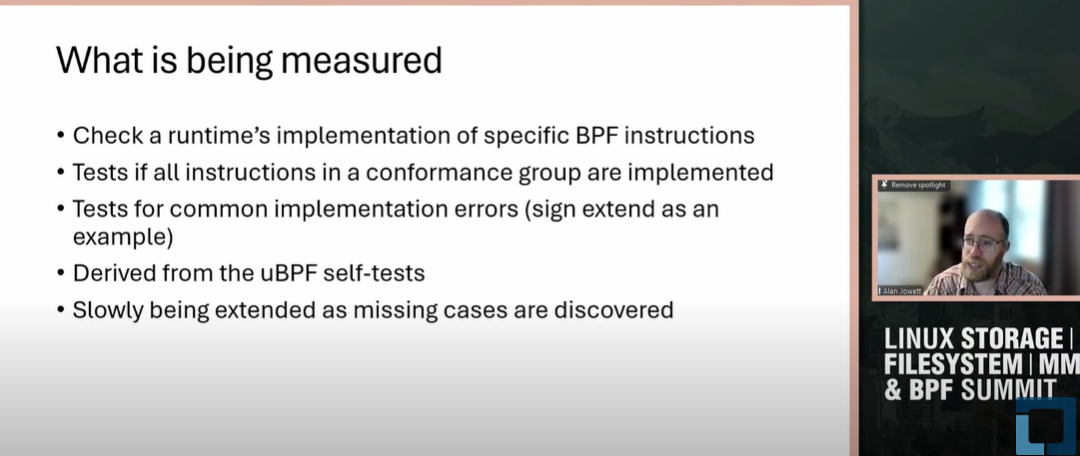The recent Linux Storage, Filesystems, MM, and BPF Summit featured a session titled “BPF conformance – handling undefined opcodes,” presented by Alan Jowett from Microsoft (video follows below). As a member of the eBPF Steering Committee, Alan brought a wealth of knowledge and expertise to the discussion. Here’s a summary of the key points from his presentation.
Introduction to BPF Conformance
Jowett introduced the BPF conformance project, highlighting its origins and goals. The project, born from collaborative efforts with Dave Thaler, aims to measure whether a specific BPF runtime complies with the ITF BPF specifications. This compliance is crucial for ensuring that BPF programs behave consistently across different environments and runtimes.
Importance of Conformance
- Consistency and Safety: Conformance testing ensures that BPF runtimes execute instructions as specified, preventing discrepancies that could lead to unsafe program behavior. If the verifier and runtime disagree on a program’s safety, it could result in erroneous safety claims.
- Portability: Developers gain confidence that their BPF programs will run correctly on various platforms, fostering a more robust ecosystem.
Testing Methodology
The BPF conformance tests are structured around three key components:
- Pre-conditions: These define the initial state of the runtime, including register states, stack contents, and memory contents.
- Code Execution: This involves running a block of BPF instructions.
- Post-conditions: Initially focused on the R0 exit code, the tests verify the final state after execution. The goal is to extend this to more comprehensive post-conditions over time.
Current Usage and Benefits
The conformance tests are actively used by multiple projects, including eBPF for Windows and the Prevail verifier. These tests not only validate internal models but also demonstrate the portability of BPF programs across different implementations, such as the rbpf runtime.
Challenges and Open Questions
Alan highlighted several challenges and open questions that the BPF conformance project faces:
- Undefined Opcodes: One significant challenge is deciding how to handle undefined opcodes. The ITF BPF specification does not dictate behavior for these, leading to uncertainty about testing their conformance.
- Test Coverage: Ensuring comprehensive test coverage is an ongoing challenge. Alan mentioned the need for a machine-readable model of the BPF specification to automate test generation and fill existing gaps.
- Negative Tests: The project currently focuses on positive tests. There is debate over the value and implications of adding negative tests, which could identify unsupported opcodes or vendor-specific extensions.
- Helper Functions: Determining which platforms and functions to include in conformance tests remains an open question. The community’s input is sought to define a common subset of helper functions for testing.
Jowett’s session on BPF conformance provided valuable insights into the importance, methodology, and challenges of ensuring BPF runtime compliance. The ongoing efforts to expand test coverage and address undefined opcodes will be critical for the project’s success. As the BPF community continues to evolve, contributions and feedback from developers will play a vital role in shaping the future of BPF conformance testing.

